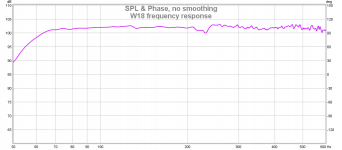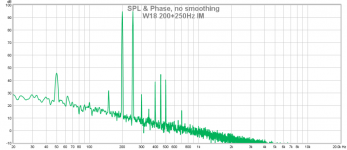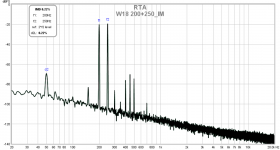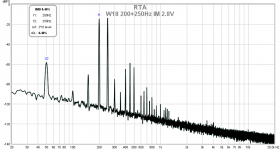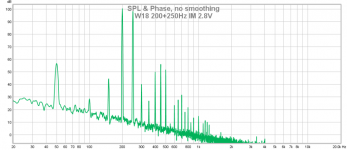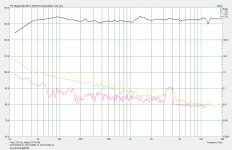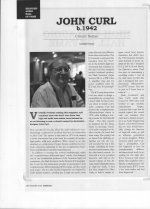An article is expected. My question is, are you comfortable presenting to several hundred people??. but I would do it for an article or a particularly insistent friend.
never mind air resistance. Think eddy drag and eddy drag flux exclusion..It turns out the sidebands right next to 200/250Hz require an extra distortion mechanism, maybe nonlinear air resistance. Also it is hard to get the harmonics to decay as fast as they do in PMA's.
What do you mean by that..can you make an output file for excel?The time domain simulation is practically what SPICE was designed for. But it won't transfer directly to a real time system.
It is hard to tell from the published literature. Most of what I've found is glossy overview. I had hoped to see how your model output differs from theirs, but have not found an actual model they have presented which produces any output spectra.What are Klippel and all these guys thinking???
It is very easy to not be contradicted when you provide nothing that can be proven incorrect.
You do not suffer that malady, thank you. I prefer collaboration with people who are not worried about being incorrect. I may be unique in that, but I hope not..
Jn
Last edited:
If I get the 50Hz and 150Hz+300Hz sidebands right, then the 200/250Hz harmonics are 15db too high. If I ignore the sidebands I can add distortions to get the harmonics right, but the 4th harmonic ends up being too high. It could be a crossover is modifying the speaker response and/or a vented motor structure is adding it's own distortion into the mix. It will be something I neglected to model, obviously.
I haven't decided on a way to model the ninja eddies. Do these eddies cause 3rd harmonics?
Does the eddy resistance increase with velocity or acceleration?
Does it increase with current or current squared or cubed? Or maybe it's square root? That actually makes more sense to me...
I tried reading some papers on the magnet falling through a tube, but they aren't very helpful.
I haven't decided on a way to model the ninja eddies. Do these eddies cause 3rd harmonics?
Does the eddy resistance increase with velocity or acceleration?
Does it increase with current or current squared or cubed? Or maybe it's square root? That actually makes more sense to me...
I tried reading some papers on the magnet falling through a tube, but they aren't very helpful.
Last edited:
Is there any evidence of this at all, even the tiniest little bit? A change of "tone" should be easy to prove, unless, of course you don't mean tone, which is probably why you used quotation marks?
One day I will get around to measuring/documenting the effects I speak of here and previously.
In the meantime I have observations rigorously subjectively proven
So then "no", not even a lttle bit.
The bottom line is that noise excites and drives further noise production
That seems simple enough. At least you propose a vaguely "real" sounding, and testable, mechanism, although your description of the effect is a bit vague. We would all love to see your data.
By suitably applied filtering this noise production can be effectively quenched
Excellent! That should be easy to demonstrate and quantify. Do you mean that the overall noise magnitude is measurably decreased, or that the noise spectral density is measurably changed, or both? And your filtering only affects the noise, not the signal, right? Again, really looking forward to seeing the data. I hope it can be reproduced so we can take it seriously.
Swapping out for example the system AC power cable will alter downstream system noise production amplitude and spectral/dynamic nature.
Ditto swapping out just one system semiconductor or passive component will both filter noise and introduce characteristic noise with consequential change in final system transduced output.
Again, those should be easy to demonstrate and quantify. Funny how all the vendors of expensive power cords have been unable to provide measurements that support these assertions up to now. Maybe they measured the wrong things, or their stuff doesn't work as well as yours.
Anyway I am very excited about your breakthrough after all these years. Will you give us a peek at your data here before you publish? (Presumably in the Journal of Irreproducible Results.)
Some further thoughts on the ninja eddies.
Unlike eddy currents generated by a stationary coil, the eddy currents of a moving dipole magnet start in one direction and then reverse. It would seem the resistance of the currents to reversing would impose a limit on the maximum braking field. Inductance would be the principle limitation. Of course with eddy currents and variable current distribution, L and R could be anywhere depending on frequency.
I think a tube with no inductance (superconductor) would oppose a change in acceleration (keeping a magnet locked to one location), whereas a tube with inductance but no resistance would act like a spring, and a tube with just resistance would provide resistance. In videos, superconductive levitation always seems to behave somewhere between a spring and mechanical fixation.
Here's a question, do the current bands above and blow the magnet get closer together if the magnet accelerates? I think it would happen if it accelerates because that is like compressing the inductive spring. But then this brings the question of when the current distribution changes, what are the new L/R characteristics? It would always be somewhere between an inductor and a resistor. But if the current distribution has 2 dimensions of freedom at once, axial and radial, then maybe the resistance will dominate, explaining why the magnet in tube experiment doesn't seem to have any springiness.
Unlike eddy currents generated by a stationary coil, the eddy currents of a moving dipole magnet start in one direction and then reverse. It would seem the resistance of the currents to reversing would impose a limit on the maximum braking field. Inductance would be the principle limitation. Of course with eddy currents and variable current distribution, L and R could be anywhere depending on frequency.
I think a tube with no inductance (superconductor) would oppose a change in acceleration (keeping a magnet locked to one location), whereas a tube with inductance but no resistance would act like a spring, and a tube with just resistance would provide resistance. In videos, superconductive levitation always seems to behave somewhere between a spring and mechanical fixation.
Here's a question, do the current bands above and blow the magnet get closer together if the magnet accelerates? I think it would happen if it accelerates because that is like compressing the inductive spring. But then this brings the question of when the current distribution changes, what are the new L/R characteristics? It would always be somewhere between an inductor and a resistor. But if the current distribution has 2 dimensions of freedom at once, axial and radial, then maybe the resistance will dominate, explaining why the magnet in tube experiment doesn't seem to have any springiness.
It could be a crossover is modifying the speaker response
Yes there is a crossover, it was measured on a completed 2-way box, 10cm from woofer cone. The crossover flattens woofer response, see the plot (if you look at the W18 datasheet you will see it is necessary). However, point of crossover is at 2700Hz. I do not think that 200+250Hz sidebands and H2, H3 are affected much by the crossover circuit. And, it is an operating status.
Attachments
Ok, but if anyone is serious about speakers, the crossover is the first thing to go, has to be bi- or tri- amped surely!
If one is serious about speaker FR measurement presentation, one use a 50dB scale range on the y-axis 😉
//
//
Keantoken, here is the repeated 250+250Hz IM measurement, voltage drive, 1.4Vrms. I am attaching not only plots, but also a zip file that contains a txt export from REW of the spectrum plot.
Attachments
Since the point was brought up, here is a measurement of a speaker with two 5.25 " wooferettes.
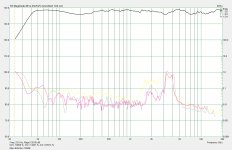
100 dB anaechoic is seriously loud when boundaries are present. In stereo this combines on the low end to 106dB, plus room gain, it is enough for large rooms. Tweeter begins to fall apart, but on the low end distortion remains < .1 %.
It is not the size but what you do with it.

100 dB anaechoic is seriously loud when boundaries are present. In stereo this combines on the low end to 106dB, plus room gain, it is enough for large rooms. Tweeter begins to fall apart, but on the low end distortion remains < .1 %.
It is not the size but what you do with it.
The magnet in tube is somewhat different from what we need. The copper tube is fighting the change in field, in this case along the tube axis. It is creating a circumferential current as depicted, that is an inductive storage, and it's field will fight the magnet's advance. It is also fighting the return path of the magnet's field from north to south, those will dissipate energy.Some further thoughts on the ninja eddies.
Unlike eddy currents generated by a stationary coil, the eddy currents of a moving dipole magnet start in one direction and then reverse. It would seem the resistance of the currents to reversing would impose a limit on the maximum braking field. Inductance would be the principle limitation. Of course with eddy currents and variable current distribution, L and R could be anywhere depending on frequency.
I think a tube with no inductance (superconductor) would oppose a change in acceleration (keeping a magnet locked to one location), whereas a tube with inductance but no resistance would act like a spring, and a tube with just resistance would provide resistance. In videos, superconductive levitation always seems to behave somewhere between a spring and mechanical fixation.
Here's a question, do the current bands above and blow the magnet get closer together if the magnet accelerates? I think it would happen if it accelerates because that is like compressing the inductive spring. But then this brings the question of when the current distribution changes, what are the new L/R characteristics? It would always be somewhere between an inductor and a resistor. But if the current distribution has 2 dimensions of freedom at once, axial and radial, then maybe the resistance will dominate, explaining why the magnet in tube experiment doesn't seem to have any springiness.
An aluminum former is slit to prevent the inductive storage of a shorted ring secondary to the vc current.
If you move the former in the gap, it will fight the gap field intrusion into the metal with a force. The braking force is proportional to the velocity, and will have also a dependence on where the front and back edges are with respect to the flux field.
Eddies in the magnet structure will be dependent on velocity, current, position,and rate of change of the current. (not necessarily linearly independent, but also a function of the products)
Underhung/overhung will make a difference as well, as the vc field drives in the front and back surface of the front plate when centered, but an underhung will have field lines perpendicular to the inner surface of the front plate when the coil has driven in. So current induced eddies are more of a function of x, I, geometry (and not linear/independent but a product of)
That is why I am interested in the temporal results. A non linear suspension compliance will dissipate more during extreme cone excursions at maximum x, while former dissipation will be when the coil is centered and moving at it's fastest speed. Both remove energy at twice the movement frequency, but they act at different times in the waveform. There is the possibility that both have roughly the same distortion spectral content, and the plots shown only give spectra. It's like looking at an FFT of some signal and trying to reconstruct the waveshape based only on spectral content. A specific waveform will have only one spectral content plot, whereas a spectral content plot cannot be used to reconstruct the waveform, there is insufficient information available, as phase is lost.
If you think modelling all these eddy contributions is easy, I have a bridge to sell you. 😀
jn
Also, be wary and careful when discussing superconductivity, levitation, and magnetic fields. While it seems the same, there are some very important distinctions that set them apart.
In the videos, the superconductors will create currents as they are immersed into a magnetic field, but when motion is finished, the currents will continue infinitely, for non supers, the currents die out. Another thing supers do is called "flux pinning". It is a rather weird mechanism involving flux pinning sites. Pinning sites have been created by impurities, by ion implantation, etc, and are needed to increase the critical currents of the super in use, makes them better. They will fight magnetic intrusion by setting up currents until their critical current is exceeded, then it fails by reverting back to normal material. That is one big caveat to using superconducting wires, as if they "quench", or become normal, the massive currents they were carrying will quickly destroy the wire if the power is not shut off in time. An 18 gauge superconducting wire carrying 2000 amps DC will vaporize in a second of two if that transition is not noticed..just ask CERN, their cable was carrying 13 kiloamps.
Last edited:
The laws of physics are still dominant in speaker design. Not, some specialty E/M or wishful measurements. If a person wants to understand and perhaps improve a loudspeaker design, then they should 'hit the books' first, with whatever they think is appropriate. Personally I find the 50-75 year old stuff equally valuable, but IF you insist on contemporary, then read all the Klippel articles. That is at least, accurate! Now, that should not depress you into thinking that something that might not be overlooked! Of course, you are still in a position to do something different and useful, but it will be 'real' not just intellectual hype. Don't waste your time with just fooling around.
Says the man who fools around with bybees? Sorry John, this really cannot be taken seriously coming from you.
Re "old books", a lot has changed in speaker design and measurements and diagnosis since Harry Olson times. Even since my graduating in 1979, speaker design has moved a lot. Drivers are more linear, speakers have much better frequency response, and the computer analysis enabled something that was impossible - study of directional behavior of drivers and speakers, in a 3D space, which is probably the biggest achievement in last decades. Speakers have much better directional and controlled directional behavior, which results in much more natural sound and much less sound colorization. This is extremely important especially for those of us who like to listen classical music, big orchestra. Yes, for FM radio playing club jazz or some background music it is not much important. However, it would be greatly irresponsible to say that everything in electro-acoustics was designed 70 years ago.
The magnet in tube is somewhat different from what we need. The copper tube is fighting the change in field, in this case along the tube axis. It is creating a circumferential current as depicted, that is an inductive storage, and it's field will fight the magnet's advance. It is also fighting the return path of the magnet's field from north to south, those will dissipate energy.
An aluminum former is slit to prevent the inductive storage of a shorted ring secondary to the vc current.
I was meaning eddy currents in the pole piece, but I can see how it would apply for the former.
If you move the former in the gap, it will fight the gap field intrusion into the metal with a force. The braking force is proportional to the velocity, and will have also a dependence on where the front and back edges are with respect to the flux field.
If the former is unrolled, the current induced eddy looks like a loop around the surface of the square sheet of aluminum. Unlike the magnet through the tube, the B field does not also pass through the former or take two passes through it. This is also different from the case of an underhung voicecoil, where it's flux passes in and out of the surface of the pole piece.
It's like looking at an FFT of some signal and trying to reconstruct the waveshape based only on spectral content. A specific waveform will have only one spectral content plot, whereas a spectral content plot cannot be used to reconstruct the waveform, there is insufficient information available, as phase is lost.
I'm sorry if you were under the illusion I posted that to be informative. What I said was, it looks nice.
Attached pictures are informational. Top trace is the force on the cone. Orange is the reluctance force. Red is the force due to eddies in either the shorting ring or the pole piece. Note that it has a rising DC component as the eddy voltage is polarizing the eddy inductance.
The distortions are similar, but out of phase. I thought about trying to use a laminated shorting ring to bring them more into phase hoping they will cancel, but the eddy force leads the reluctance force, what is actually needed is a zero resistance shorting ring (EDIT: Nevermind, the phase still isn't correct to cancel, and even if it was it would only be at one frequency). The closest thing to that is a driven coil as discussed previously.
Note the reluctance force should be pulling the cone in and the eddy force should push it away. The magnetics equations treat attraction as a positive force and repulsion as negative, but in a speaker repulsion is positive and attraction is negative. So I need to flip the polarity in the output.
Attachments
Last edited:
PMA quibbling with me as to the AGE of the textbooks on speaker design does little to give more insight. The basic equation is: MX(..) + BX(.) + KX = F This was put on paper, for instance, in 1925 by Rice and Kellogg describing the invention of the direct radiator loudspeaker. The mechanical 'LAWS OF PHYSICS' have not deviated since then. I suspect that many here, with all their concern about magnetic linearity, have little or no actual understanding of how a typical loudspeaker works. Now, what sources on speaker design do YOU recommend? I already mentioned Klippel. Who else?
The laws of physics are still dominant in speaker design. Not, some specialty E/M or wishful measurements. If a person wants to understand and perhaps improve a loudspeaker design, then they should 'hit the books' first, with whatever they think is appropriate.
Your "books" are incomplete and inaccurate. We are working towards advancing knowledge. I do not care if you understand it or not. And, I equally do not care about your opinion regarding what we are doing.
This is familiar territory for me. Most of the tasks that are requested of me are not in the books, so I have to write new chapters. And none of the people I deal with would be so arrogant or stupid as to say what you just did.
None.
Personally I find the 50-75 year old stuff equally valuable, but IF you insist on contemporary, then read all the Klippel articles. That is at least, accurate!
No, they are not all accurate, nor complete. None of your sources are. Klippel is not contemporary, he is in the past. I look forward.
We are not wasting our time doing the work.Now, that should not depress you into thinking that something that might not be overlooked! Of course, you are still in a position to do something different and useful, but it will be 'real' not just intellectual hype. Don't waste your time with just fooling around.
However, it is indeed a waste of time paying attention to the ridiculous blather of someone who lives in the past and rejects actual science.
jn
Last edited:
PMA quibbling with me as to the AGE of the textbooks on speaker design does little to give more insight. The basic equation is: MX(..) + BX(.) + KX = F This was put on paper, for instance, in 1925 by Rice and Kellogg describing the invention of the direct radiator loudspeaker. The mechanical 'LAWS OF PHYSICS' have not deviated since then. I suspect that many here, with all their concern about magnetic linearity, have little or no actual understanding of how a typical loudspeaker works. Now, what sources on speaker design do YOU recommend? I already mentioned Klippel. Who else?
So, where is the part of the force equation relating the velocity and conductivity of the former, and it's relationship to Qm??? Aluminum formers are well known to alter Qm.
You have much learning to do John. Waving your fist at the planes flying overhead accomplishes nothing.
jn
- Status
- Not open for further replies.
- Home
- Member Areas
- The Lounge
- John Curl's Blowtorch preamplifier part III
